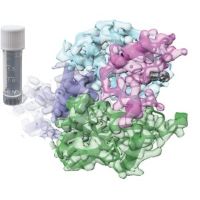Specification
| Description | Recombinant protein from the full-length sequence of homo sapiens X-ray repair cross complementing 6 (XRCC6), transcript variant 1 (NM_001469). |
| Organism | Homo sapiens (Human) |
| Expression Host | Human Cells |
| Tag Info | His or DYKDDDDK. Please contact us if you need further information or require specific designed tag. |
| Purity | Greater than 90% by SDS-PAGE gel |
| Uniprot ID | P12956 |
| Entry Name | XRCC6_HUMAN |
| Gene Names | XRCC6 G22P1 |
| Alternative Gene Names | G22P1 |
| Alternative Protein Names | X-ray repair cross-complementing protein 6 (EC 3.6.4.-) (EC 4.2.99.-) (5'-deoxyribose-5-phosphate lyase Ku70) (5'-dRP lyase Ku70) (70 kDa subunit of Ku antigen) (ATP-dependent DNA helicase 2 subunit 1) (ATP-dependent DNA helicase II 70 kDa subunit) (CTC box-binding factor 75 kDa subunit) (CTC75) (CTCBF) (DNA repair protein XRCC6) (Lupus Ku autoantigen protein p70) (Ku70) (Thyroid-lupus autoantigen) (TLAA) (X-ray repair complementing defective repair in Chinese hamster cells 6) |
| Application | Antigens, Western, ELISA and other in vitro binding or in vivo functional assays, and protein-protein interaction studies; For research & development use only! |
| Buffer | Purified protein formulated in a sterile solution of PBS buffer, pH7.2, without any preservatives |
| Endotoxin | Endotoxin level is < 0.1 ng/µg of protein (<1EU /µg) |
| Length | 609 |
| Molecular Weight(Da) | 69843 |
| Protein Sequence | (The sequence of expressed protein may have some variation from the sequence shown below. Please contact us for the exact sequence.) MSGWESYYKTEGDEEAEEEQEENLEASGDYKYSGRDSLIFLVDASKAMFESQSEDELTPFDMSIQCIQSVYISKIISSDRDLLAVVFYGTEKDKNSVNFKNIYVLQELDNPGAKRILELDQFKGQQGQKRFQDMMGHGSDYSLSEVLWVCANLFSDVQFKMSHKRIMLFTNEDNPHGNDSAKASRARTKAGDLRDTGIFLDLMHLKKPGGFDISLFYRDIISIAEDEDLRVHFEESSKLEDLLRKVRAKETRKRALSRLKLKLNKDIVISVGIYNLVQKALKPPPIKLYRETNEPVKTKTRTFNTSTGGLLLPSDTKRSQIYGSRQIILEKEETEELKRFDDPGLMLMGFKPLVLLKKHHYLRPSLFVYPEESLVIGSSTLFSALLIKCLEKEVAALCRYTPRRNIPPYFVALVPQEEELDDQKIQVTPPGFQLVFLPFADDKRKMPFTEKIMATPEQVGKMKAIVEKLRFTYRSDSFENPVLQQHFRNLEALALDLMEPEQAVDLTLPKVEAMNKRLGSLVDEFKELVYPPDYNPEGKVTKRKHDNEGSGSKRPKVEYSEEELKTHISKGTLGKFTVPMLKEACRAYGLKSGLKKQELLEALTKHFQD |
Background
| Function | FUNCTION: Single-stranded DNA-dependent ATP-dependent helicase that plays a key role in DNA non-homologous end joining (NHEJ) by recruiting DNA-PK to DNA (PubMed:7957065, PubMed:8621488, PubMed:12145306, PubMed:11493912, PubMed:20493174, PubMed:2466842, PubMed:9742108). Required for double-strand break repair and V(D)J recombination (PubMed:7957065, PubMed:8621488, PubMed:12145306, PubMed:11493912, PubMed:20493174, PubMed:2466842, PubMed:9742108). Also has a role in chromosome translocation (PubMed:7957065, PubMed:8621488, PubMed:12145306, PubMed:11493912, PubMed:20493174, PubMed:2466842, PubMed:9742108). Has a role in chromosome translocation (PubMed:7957065, PubMed:20493174, PubMed:2466842, PubMed:9742108, PubMed:8621488, PubMed:12145306, PubMed:11493912). The DNA helicase II complex binds preferentially to fork-like ends of double-stranded DNA in a cell cycle-dependent manner (PubMed:7957065, PubMed:8621488, PubMed:20493174, PubMed:2466842, PubMed:9742108, PubMed:12145306, PubMed:11493912). It works in the 3'-5' direction (PubMed:20493174, PubMed:2466842, PubMed:9742108, PubMed:7957065, PubMed:8621488, PubMed:12145306, PubMed:11493912). During NHEJ, the XRCC5-XRRC6 dimer performs the recognition step: it recognizes and binds to the broken ends of the DNA and protects them from further resection (PubMed:7957065, PubMed:8621488, PubMed:20493174, PubMed:2466842, PubMed:9742108, PubMed:12145306, PubMed:11493912). Binding to DNA may be mediated by XRCC6 (PubMed:20493174, PubMed:2466842, PubMed:9742108, PubMed:7957065, PubMed:8621488, PubMed:12145306, PubMed:11493912). The XRCC5-XRRC6 dimer acts as regulatory subunit of the DNA-dependent protein kinase complex DNA-PK by increasing the affinity of the catalytic subunit PRKDC to DNA by 100-fold (PubMed:7957065, PubMed:8621488, PubMed:12145306, PubMed:11493912, PubMed:20493174, PubMed:2466842, PubMed:9742108). The XRCC5-XRRC6 dimer is probably involved in stabilizing broken DNA ends and bringing them together (PubMed:7957065, PubMed:8621488, PubMed:12145306, PubMed:11493912, PubMed:20493174, PubMed:2466842, PubMed:9742108). The assembly of the DNA-PK complex to DNA ends is required for the NHEJ ligation step (PubMed:7957065, PubMed:8621488, PubMed:12145306, PubMed:11493912, PubMed:20493174, PubMed:2466842, PubMed:9742108). Probably also acts as a 5'-deoxyribose-5-phosphate lyase (5'-dRP lyase), by catalyzing the beta-elimination of the 5' deoxyribose-5-phosphate at an abasic site near double-strand breaks (PubMed:20383123). 5'-dRP lyase activity allows to 'clean' the termini of abasic sites, a class of nucleotide damage commonly associated with strand breaks, before such broken ends can be joined (PubMed:20383123). The XRCC5-XRRC6 dimer together with APEX1 acts as a negative regulator of transcription (PubMed:8621488). In association with NAA15, the XRCC5-XRRC6 dimer binds to the osteocalcin promoter and activates osteocalcin expression (PubMed:12145306). Plays a role in the regulation of DNA virus-mediated innate immune response by assembling into the HDP-RNP complex, a complex that serves as a platform for IRF3 phosphorylation and subsequent innate immune response activation through the cGAS-STING pathway (PubMed:28712728). {ECO:0000269|PubMed:11493912, ECO:0000269|PubMed:12145306, ECO:0000269|PubMed:20383123, ECO:0000269|PubMed:20493174, ECO:0000269|PubMed:2466842, ECO:0000269|PubMed:28712728, ECO:0000269|PubMed:7957065, ECO:0000269|PubMed:8621488, ECO:0000269|PubMed:9742108}. |
| Pathway | |
| Protein Families | Ku70 family |
| Tissue Specificity |
QC Data
| Note | Please contact us for QC Data |
| Product Image (Reference Only) |  |

